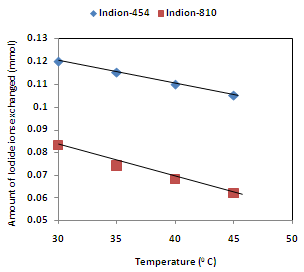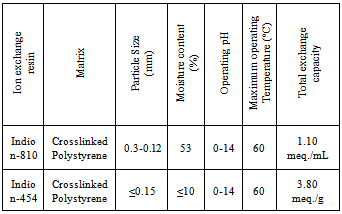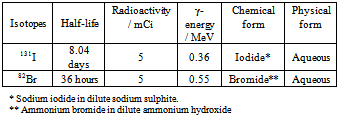-
Paper Information
- Next Paper
- Previous Paper
- Paper Submission
-
Journal Information
- About This Journal
- Editorial Board
- Current Issue
- Archive
- Author Guidelines
- Contact Us
International Journal of Materials and Chemistry
p-ISSN: 2166-5346 e-ISSN: 2166-5354
2012; 2(4): 151-157
doi: 10.5923/j.ijmc.20120204.07
Comparative Study of Indion-810 and Indion -454 Strongly Basic Anion Exchange Resins by Application of 131I and 82 Br as a Tracer Isotopes
Pravin U. Singare
Department of Chemistry, Bhavan’s College, Munshi Nagar, Andheri (West), Mumbai, 400 058, India
Correspondence to: Pravin U. Singare , Department of Chemistry, Bhavan’s College, Munshi Nagar, Andheri (West), Mumbai, 400 058, India.
| Email: |  |
Copyright © 2012 Scientific & Academic Publishing. All Rights Reserved.
The present investigation deals with application of radiotracer isotopes 131I and 82Br for performance assessment of industrial grade strongly basic anion exchange resins Indion-810 and Indion -454. The study reveals the higher percentage of ions exchanged by Indion -454 resins as compared to Indion-810 under identical experimental conditions. It is observed that iodide ions are exchanged at the faster rate than bromide ions; however the exchange rate decreases with rise in temperature and increases with increase in ionic concentration. The study indicates strong positive correlation between amount of ions exchanged and concentration of ionic solution, and a strong negative correlation between amount of ions exchanged and temperature of the exchanging solution.
Keywords: Radiotracer Isotopes, 82Br, 131I, Ion-Isotopic Exchange, Reaction Kinetics, Ion Exchange Resins, Indion-810, Indion -454
Cite this paper: Pravin U. Singare , "Comparative Study of Indion-810 and Indion -454 Strongly Basic Anion Exchange Resins by Application of 131I and 82 Br as a Tracer Isotopes", International Journal of Materials and Chemistry, Vol. 2 No. 4, 2012, pp. 151-157. doi: 10.5923/j.ijmc.20120204.07.
Article Outline
1. Introduction
- Ion-exchange resins are produced and commercialized in a wide range of formulations with different characteristics, and have now a large practical applicability in various industrial processes, such as chemical, nuclear, pharmaceutical, food industry, etc. Nowadays, ion exchange resins are not only used for separation but also used as a catalyst. In the past decade inorganic ion exchange materials have emerged as an increasingly important replacement or complement for conventional organic ion exchange resins. However in number of cases, for specific physical and chemical reasons, organic resins cannot be replaced by inorganic ion exchangers and organic ion exchange resins continue globally in various industrial applications[1-3]. Therefore development of new organic ion exchange materials for specific industrial and technological applications is a biggest challenge to present day researchers. Development of ion exchange resins is usually followed by characterization to understand the performance of those resins in various technological applications. Although number of techniques are available for the characterization of ion exchange resins, but the radiotracer technique offer several advantages such as high detection sensitivity, capability of in-situ detection, limited memory effects and physic-chemical compatibility with the material under study. There are two main reasons for the continuing interest in application of radiotracer technique. Firstly, it is industry driven. Because of their unique properties, radioactive isotopes can be used to obtain information about plants and processes that cannot be obtained in any other way. Often, the information is obtained with the plant on-stream and without disrupting the process in any way. This can lead to substantial economic benefits, from shutdown avoidance to process optimization. Secondly, the methodology is derived from many fields of science and technology including radioisotope production, radiation detection, data acquisition, treatment and analysis, and mathematical modelling. The fundamental principle in radiochemical investigations is that the chemical properties of a radioisotope of an element are almost the same as those of the other stable/radioactive isotopes of the element. When radioisotope is present in a chemical form identical to that of the bulk of the element in a chemical process, then any reaction the element undergoes can be directly traced by monitoring the radioisotope. Radioisotope can also be tagged to a molecule or material to follow a process. Radiochemical work involves two main steps first is the sampling of chemical species to be studied and second is quantitative determination of the radiation emitted by the radioisotope in the sample[4]. Radiotracer methodology is described extensively in the literature[5]. Applications of radiotracers in chemical research cover the studies of reaction mechanism, kinetics, exchange processes and analytical applications such as radiometric titrations, solubility product estimation, isotope dilution analysis and autoradiography.Hence in the present investigation, radiotracer isotopes are applied to assess the performance of industrial grade ion exchange resin under different experimental conditions like temperature and concentration of ionic species present in the external exchanging medium.
2. Experimental
2.1. Conditioning of Ion Exchange Resins
- Ion exchange resins Indion-810 and Indion-454 (by Ion Exchange India Ltd., Mumbai) are strongly basic anion exchange resin in chloride form having quaternary ammonium -N+R3 functional group. Details regarding the properties of the resins used are given in Table 1. These resins were converted separately in to iodide / bromide form by treatment with 10 % KI / KBr solution in a conditioning column which is adjusted at the flow rate as 1 mL / min. The resins were then washed with double distilled water, until the washings were free from iodide/bromide ions as tested by AgNO3 solution. These resins in bromide and iodide form were then dried separately over P2O5 in desiccators at room temperature.
|
2.2. Radioactive Tracer Isotopes
- The radioisotope 131I and 82Br used in the present experimental work was obtained from Board of Radiation and Isotope Technology (BRIT), Mumbai. Details regarding the isotopes used in the present experimental work are given in Table 2.
|
2.3. Study on Kinetics of Iodide Ion-Isotopic Exchange Reaction
- In a stoppered bottle 250 mL (V) of 0.001 M iodide ion solution was labeled with diluted 131I radioactive solution using a micro syringe, such that 1.0 mL of labeled solution has a radioactivity of around 15,000 cpm (counts per minute) when measured with γ -ray spectrometer having NaI (Tl) scintillation detector. Since only about 50–100 μL of the radioactive iodide ion solution was required for labeling the solution, its concentration will remain unchanged, which was further confirmed by potentiometer titration against AgNO3 solution. The above labeled solution of known initial activity (Ai) was kept in a thermostat adjusted to 30.0 °C. The swelled and conditioned dry ion exchange resins in iodide form weighing exactly 1.000 g (m) were transferred quickly into this labeled solution which was vigorously stirred by using mechanical stirrer and the activity in cpm of 1.0 mL of solution was measured. The solution was transferred back to the same bottle containing labeled solution after measuring activity. The iodide ion-isotopic exchange reaction can be represented as:
 | (1) |
2.4. Study on Kinetics of Bromide Ion-Isotopic Exchange Reaction
- The experiment was also performed to study the kinetics of bromide ion- isotopic exchange reaction by equilibrating 1.000 g of ion exchange resin in bromide form with labeled bromide ion solution in the same concentration and temperature range as above. The labeling of bromide ion solution was done by using 82Br as a radioactive tracer isotope for which the same procedure as explained above was followed. The bromide ion-isotopic exchange reaction can be represented as:
 | (2) |
3. Results and Discussion
3.1. Comparative Study of Ion-Isotopic Exchange Reactions
- In the present investigation it was observed that due to the rapid ion-isotopic exchange reaction taking place, the activity of solution decreases rapidly initially, then due to the slow exchange the activity of the solution decreases slowly and finally remains nearly constant. Preliminary studies show that the above exchange reactions are of first order[14, 15]. Therefore logarithm of activity when plotted against time gives a composite curve in which the activity initially decreases sharply and thereafter very slowly giving nearly straight line (Figure 1), evidently rapid and slow ion-isotopic exchange reactions were occurring simultaneously[7-13]. Now the straight line was extrapolated back to zero time. The extrapolated portion represents the contribution of slow process to the total activity which now includes rapid process also. The activity due to slow process was subtracted from the total activity at various time intervals. The difference gives the activity due to rapid process only. From the activity exchanged due to rapid process at various time intervals, the specific reaction rates (k) of rapid ion-isotopic exchange reaction were calculated. The amount of iodide / bromide ions exchanged (mmol) on the resin were obtained from the initial and final activity of solution and the amount of exchangeable ions in 250 mL of solution. From the amount of ions exchanged on the resin (mmol) and the specific reaction rates (min-1), the initial rate of ion exchanged (mmol/min) was calculated. Because of larger solvated size of bromide ions as compared to that of iodide ions, it was observed that the exchange of bromide ions occurs at the slower rate than that of iodide ions[16]. Hence under identical experimental conditions, the values of specific reaction rate (min-1), amount of ion exchanged (mmol) and initial rate of ion exchange (mmol/min) are calculated to be lower for bromide ion-isotopic exchange reaction than that for iodide ion-isotopic exchange reaction as summarized in Tables 3 and 4. For both bromide and iodide ion-isotopic exchange reactions, under identical experimental conditions, the values of specific reaction rate increases with increase in concentration of ionic solution from 0.001M to 0.004M (Table 3). However, with rise in temperature from 30.0℃ to 45.0℃, the specific reaction rate was observed to decrease (Table 4). From the results, it appears that iodide ions exchange at the faster rate as compared to that of bromide ions which was related to the extent of solvation (Tables 3 and 4).
|
 | Figure 2. Variation in Percentage Ions Exchanged with Concentration of Labeled Ionic Solution Amount of ion exchange resin = 1.000 g, Volume of labeled ionic solution = 250 mL, Temperature = 30.0℃ |
 | Figure 3. Variation in Percentage Ions Exchanged with Temperature of Labeled Ionic Solution Amount of ion exchange resin = 1.000 g, Concentration of labeled exchangeable ionic solution = 0.001M, Volume of labeled ionic solution = 250 mL, Amount of exchangeable ions in 250 mL labeled solution = 0.250 mmol |
 | (3) |
3.2. Comparative Study of Anion Exchange Resins
- From the Table 3, it is observed that for iodide ion-isotopic exchange reaction by using Indion-454 resin, the values of specific reaction rate (min-1), amount of iodide ion exchanged (mmol), initial rate of iodide ion exchange (mmol/min) and log Kd were 0.153, 0.120, 0.018 and 12.8 respectively, which was higher than 0.102, 0.083, 0.008 and 12.4 respectively as that obtained by using Indion-810 resins under identical experimental conditions of 30.0℃, 1.000 g of ion exchange resins and 0.001 M labeled iodide ion solution. The identical trend was observed for the two resins during bromide ion-isotopic exchange reaction.
 | Figure 4. Correlation between concentrations of iodide ion solution and amount of iodide ion exchanged Amount of ion exchange resin = 1.000 g, Volume of labeled ionic solution = 250 mL, Temperature = 30.0℃ Correlation coefficient (r) for Indion-454 = 0.9999 Correlation coefficient (r) for Indion-810 = 0.9990 |
 | Figure 5. Correlation between concentrations of bromide ion solution and amount of bromide ion exchanged Amount of ion exchange resin = 1.000 g, Volume of labeled ionic solution = 250 mL, Temperature = 30.0℃Correlation coefficient (r) for Indion-454 = 0.9994 Correlation coefficient (r) for Indion-810 = 0.9964 |
 | Figure 6. Correlation between Temperature of exchanging medium and amount of iodide ion exchanged .Amount of ion exchange resin = 1.000 g, Concentration of labeled exchangeable ionic solution = 0.001M, Volume of labeled ionic solution = 250 mL, Amount of exchangeable ions in 250 mL labeled solution = 0.250 mmol Correlation coefficient (r) for Indion-454 = -1.0000 Correlation coefficient (r) for Indion-810 = -0.9944 |
 | Figure 7. Correlation between Temperatures of exchanging medium and amount of bromide ion exchanged .Amount of ion exchange resin = 1.000 g, Concentration of labeled exchangeable ionic solution = 0.001M, Volume of labeled ionic solution = 250 mL, Amount of exchangeable ions in 250 mL labeled solution = 0.250 mmolCorrelation coefficient (r) for Indion-454 = -0.9959 Correlation coefficient (r) for Indion-810 = -0.9795 |
3.3. Statistical Correlations
- The results of present investigation show a strong positive linear co-relationship between amount of ions exchanged and concentration of ionic solution (Figures 4, 5). In case of iodide ion exchange using Indion-454 and Indion-810 resins, the values of correlation coefficient (r) were found to be 0.9999 and 0.9990, while for bromide ion exchange the values of r were 0.9994 and 0.9964 respectively. There also exist a strong negative co-relationship between amount of ions exchanged and temperature of exchanging medium (Figures 6, 7). For Indion-454 and Indion-810 resins, during iodide ion-isotopic exchange the values of r were found to be -1.0000 and -0.9944 respectively; while for bromide ion-isotopic exchange the values were calculated as -0.9959 and -0.9795 respectively for the two resins.
4. Conclusions
- The experimental work carried out in the present investigation will help to standardize the operational process parameters so as to improve the performance of selected nuclear grade ion exchange resins. The radioactive tracer technique used here can also be applied for characterization of different nuclear as well as non-nuclear grade ion exchange resins.
ACKNOWLEDGEMENTS
- The author is thankful to Professor Dr. R.S. Lokhande for his valuable help and support in carrying out the experimental work in Radiochemistry Laboratory of Department of Chemistry, University of Mumbai, Vidyanagari, Mumbai -58.The authors are extremely thankful to SAP Productions for developing and maintaining the manuscript template.
References
| [1] | International Atomic Energy Agency, 1967, Operation and Control of Ion exchange Processes for Treatment of Radioactive Wastes, Technical Report Series No. 78, IAEA, Vienna. |
| [2] | International Atomic Energy Agency, 1984, Treatment of Low and Intermediate-level Liquid Radioactive Wastes, Technical Report Series No. 236, IAEA, Vienna. |
| [3] | International Atomic Energy Agency, 2002, Application of Ion exchange processes for the treatment of Radioactive Waste and Management of Spent Ion Exchangers, Technical Report Series No.408, IAEA, Vienna. |
| [4] | Sood, D.D., Reddy, A.V.R., and Ramamoorthy, N., 2004, ‘Applications of Radioisotopes in Physico-Chemical Investigations’, in Fundamentals of Radiochemistry, Indian Association of Nuclear Chemists and Allied Scientists (IANCAS), 253-263. |
| [5] | International Atomic Energy Agency, 2004, Radiotracer Applications in Industry- A Guidebook, Safety Reports Series No. 423, IAEA, Vienna. |
| [6] | Sood, D.D., 1998, Proc. Int. Conf. on Applications of Radioisotopes and Radiation in Industrial Development, ed. Sood, D.D., Reddy, A.V.R., Iyer, S.R.K., Gangadharan, S., and Singh, G., (B.A.R.C., India), 35–53. |
| [7] | Singare, P.U., and Lokhande, R.S., 2012, Studies on Ion-Isotopic Exchange Reactions Using Nuclear Grade Ion Exchange Resins., Ionics, 18(4), 351–357. |
| [8] | Singare, P.U., Lokhande, R.S., and Patil, A.B., 2008, Application of Radioactive Tracer Technique for Characterization of some Strongly Basic Anion Exchange Resins., Radiochim. Acta, 96(2), 99-104. |
| [9] | Lokhande, R.S., and Singare, P.U., 2008, Comparative Study on Iodide and Bromide Ion-Isotopic Exchange Reactions by Application of Radioactive Tracer Technique., J.Porous Mater, 15(3), 253-258. |
| [10] | Singare, P.U., Lokhande, R.S., and Patil, A.B., 2007, Application of Radioactive Tracer Technique on Industrial Grade Ion Exchange Resins Indion-830 (Type-1) and Indion-N-IP (Type-2)., Radiochim. Acta, 95(1), 111-114. |
| [11] | Lokhande, R.S., and Singare, P.U., 2007, Comparative Study on Ion-Isotopic Exchange Reaction Kinetics by Application of Tracer Technique., Radiochim. Acta, 95(3), 173-176. |
| [12] | Lokhande, R.S., Singare, P.U., and Kolte, A.R., 2007, Study on Kinetics and Mechanism of Ion-Isotopic Exchange Reaction Using Strongly Basic Anion Exchange Resins Duolite A- 101 D and Duolite A-102 D., Radiochim. Acta, 95(10), 595-600. |
| [13] | Lokhande, R.S., Singare, P.U., and Dole, M.H., 2006, Comparative Study on Bromide and Iodide Ion-Isotopic Exchange Reactions Using Strongly Basic Anion Exchange Resin Duolite A-113., J.Nuclear and Radiochemical Sciences, 7(2), 29-32. |
| [14] | Lokhande, R.S., and Singare, P.U., 2003, Study of reversible ion-isotopic self diffusion reaction using 82 Br as a radioactive tracer isotope., Asian J. Chem., 15(1), 33-37. |
| [15] | Lokhande, R.S., and Singare, P.U., 2005, Study on kinetics of self diffusion reaction by application of 82 Br as a radioactive tracer isotope., Asian J. Chem., 17(1), 125-128. |
| [16] | Shannon, R.D., 1976, Revised effective ionic radii and systematic studies of interatomic distances in halides and chalcogenides., Acta Crystallographica, A32, 751-767. |
| [17] | Heumann, K.G., and Baier, K., 1982, Chloride distribution coefficient on strongly basic anion-exchange resin: Dependence on co-ion in alkali fluoride solutions., Chromatographia, 15(11), 701-703. |
| [18] | Adachi, S., Mizuno, T., and Matsuno, R., 1995, Concentration dependence of the distribution coefficient of maltooligosaccharides on a cation-exchange resin., J. Chromatography A, 708(2), 177-183. |
| [19] | Shuji, A., Takcshi, M., and Ryuichi, M., 1996, Temperature dependence of the distribution coefficient of maltooligosaccharides on cation-exchange resin in Na+ form., Bioscience, Biotechnology, and Biochemistry, 60(2), 338-340. |
 Abstract
Abstract Reference
Reference Full-Text PDF
Full-Text PDF Full-Text HTML
Full-Text HTML



